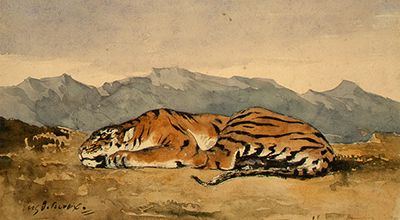Tiger is a 1830 watercolour painting by Eugene Delacroix which is broadly classed in the Orientalism art movement. It is relatively small at around 25cm in width and is one of the artist's lesser known pieces.
We find in front of us here a relatively calm scene in which the tiger takes a moment to rest. The artist places the tiger in the foreground upon a ledge, high above the ground below. In the far distance we can make out a series of mountains which are pictured in blue, with a dark sky found just behind. In comparison, the tiger's coat is bright and bold, and the posture that it takes may have been studied by the artist earlier in his career when he used to visit zoos. He would not, of course, have worked in this manner in the wild and so worked hard to find ways to produce believable content but without exposing him to considerable dangers, understanding, as he did, the inherent dangers posed by these powerful creatures.
One of the main focuses of this artist was movement. This is perhaps why he chose to make use of animals within so many of his paintings. He also had a strong connection to literature as well, and many passages which inspired him would have battles involving animals, or a symbolic use of them in all manner of different ways. They would also bring colour into his work, as well as being exciting to his local audiences who would not have been able to see these creatures up close in real life. Besides the movement, he also instilled a sense of romance and emotion, just as with all other members of the Romanticist movement and so he sought to find content which best suited that type of atmosphere. In other examples he would use horses alongside humans in their roles as subordinate workers, but he clearly preferred the image of these wonderful animals being free to roam around unhindered by humanity.
The artist adored animals and would study them in local zoos in the earlier parts of his career. Delacroix would then feature many of these species within his later paintings, though in a variety of different settings a million miles away from the Paris zoos. He learnt the fundamentals behind their postures and physical attributes and was then able to match this understanding across a variety of different scenarios. Most of the content of his work was chosen entirely by himself, rather than forced by patrons, and so we can take a lot from the items that he painted as a summary of his own tastes. One advantage of tigers specifically were the colours that they brought to his paintings, and the symbolism of these dangerous creatures who could be depicted in many different moods and actions, with this example displaying them in a less threatening manner. He also produced Tiger and Snake and Tiger Hunt.




